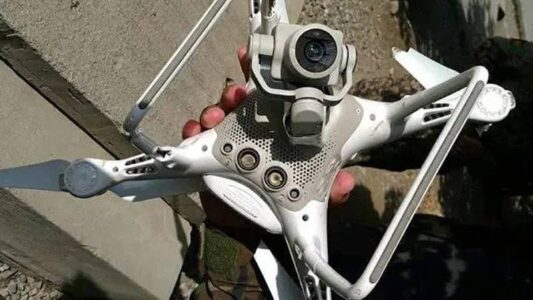
Taliban terrorists are using bomber drones as a psychological weapon
With no way to shoot down the Taliban’s drones, Afghan security forces face a hidden but deadly psychological weapon today that is likely to grow into an effective threat in the future.
As far back as 2016, the Taliban have used camera-bearing drones to shoot propaganda films. In early October 2020, they graduated to bomb-laden drones to wage war on their enemies.
While their attacks are few in number, the new tactic presents evidence of the adaptability and resilience of the group which arguably survived the American invasion of Afghanistan. More concerningly, it reflects a strategic intent to continue building fighting capacity in spite of being involved in peace negotiations with the Afghan government.
“It was very obvious that the Taliban were going to imitate American drone warfare, because what we’ve seen for a couple of years, not just in Afghanistan but also in other regions where Americans have waged war, is that militant groups try to imitate this kind of warfare,” says Emran Firoz, a drone expert who spoke to TRT World.
Unprecedented even in modern combat, the use of commercial drones casts a shadow in their opponents mind that is larger than their size. For government forces, the Taliban drones are the spearhead of psychological warfare that causes opponents to ask if they are facing a better-equipped and more advanced enemy.
“Obviously, it’s not the same technology,” says Firoz. “You can’t compare commercial drones with American Reaper drones… but they try to show off and say we can also do this. We can use drones, we have our special forces who are heavily equipped and look kind of like American special forces.”
Displaying remarkable adaptivity, the bombs dropped by these commercial drones continue to improve at a steady rate. They run the gamut from dropped mortar shells that explode on impact by default, to improvised munitions made out of plastic explosive-packed Pepsi bottles with a trigger in the bottle’s cap, to modified grenade shells meant to be fired from a grenade launcher.
Without stabilizer fins, the munition is more likely to tumble in the air, not guaranteed the impact on its nose that causes detonation. To solve this, Taliban ‘engineers’ began to attach feathered badminton shuttlecocks to the back of explosives. Not isolated to one region, Taliban drone attacks are seeing action on multiple fronts throughout Afghanistan, specifically in Paktia’s districts of Mirzaka and Zurmat, Baraki Barak, Balkh, Faryab, Charkh, and Pul-i Alam, and northern Kunduz.
No one really knows, but given at least one captured model and the sound of rotors reported by survivors of attacks, it seems likely that the Taliban are using commercially available quadcopter drones which can be manned remotely.
More explicitly, Taliban propaganda itself has no qualms with showing off its new toys. A video shared in January 2020 shows off a weaponized DJI Matrice 210 outfitted with a powerful Zenmuse Z30 zoom camera and a munition dropping mechanism. But matters may not be as clear cut as first glance may suggest.
In the video, the speaker claims the drone was actually seized by the Taliban in Afghanistan’s Helmand province after it had been allegedly used against them by an unnamed third party. This is strange, given the lack of anti-Taliban groups using commercial drones or weaponized drones to begin with. It’s worth noting that Afghanistan’s army tested surveillance drones in the same province in 2016, but they were much larger Boeing Insitu ScanEagle variants.
Drones are relatively easy to procure on the market. But in spite of that, there has been speculation that they come by way of Pakistan. In truth, Afghan officials have often been incorrect and quick to claim military equipment used by Taliban originates from Pakistan and other states.
A more telling indicator of their origin can be found in the words of Ahmad Zia Saraj, head of the National Directorate of Security (NDS). On November 23 he vowed to prohibit the import of commercial drones into Afghanistan to prevent such attacks.
But in spite of this, they’re still relatively easy to get. “There are many black markets, even in Afghanistan, from Pakistan or even China which is producing a lot of drones and exporting them all over the world, both weaponized or commercial drones.” says Firoz.
Such drones are readily available in most countries, ranging from $700 for a used drone seen in one propaganda video to nearly $6,500 for an advanced, new drone. While not inexpensive by any measure, the drones are still affordable for a large group such as the Taliban.
The Taliban reportedly brought in US$1.6 billion in their last fiscal year which ended in March 2020, according to Mullah Yaqoob, son of the late Taliban spiritual leader Mullah Mohammad Omar, compared to the Afghan government’s $5.55 billion during the same period.
In light of this, the Taliban are more than able to competitively build their own ‘poor man’s air force.’ Unlike most weapon parts or platforms, the absence of serial numbers or unique identifiers on commercial drones means procuring and smuggling them can be easily masked.
Weaponizing them is even easier, requiring basic DIY handiness and familiarity with explosives.
The question remains: why did the Taliban start arming drones only recently, in spite of using commercial drones to film suicide attacks or propaganda footage for significant time?
For Emran Firoz, it’s still about the “Americanization of war,” as militant groups “try to use similar weapons, warfighting style, just copying this warfare that is considered advanced because that’s how you make war in the 21st century,” he notes.
It’s also about the narrative.
“A few days ago, a Taliban member I know claimed they were just targeting the Afghan military but no civilians. It’s the same narrative used by everyone, even Americans, which is a lie. It’s the same regarding the Taliban,” adds Firoz.
One possible explanation is the growth of younger tech-savvy Taliban members, or possibly their inspiration by ISIL’s use of weaponized commercial drones in Syria and Iraq in 2017
“At the moment, the impacts are not huge,” says Firoz. If they continue to improve them or scale up their use, they could prove to be terrorizing weapons.
Source: TRT World





